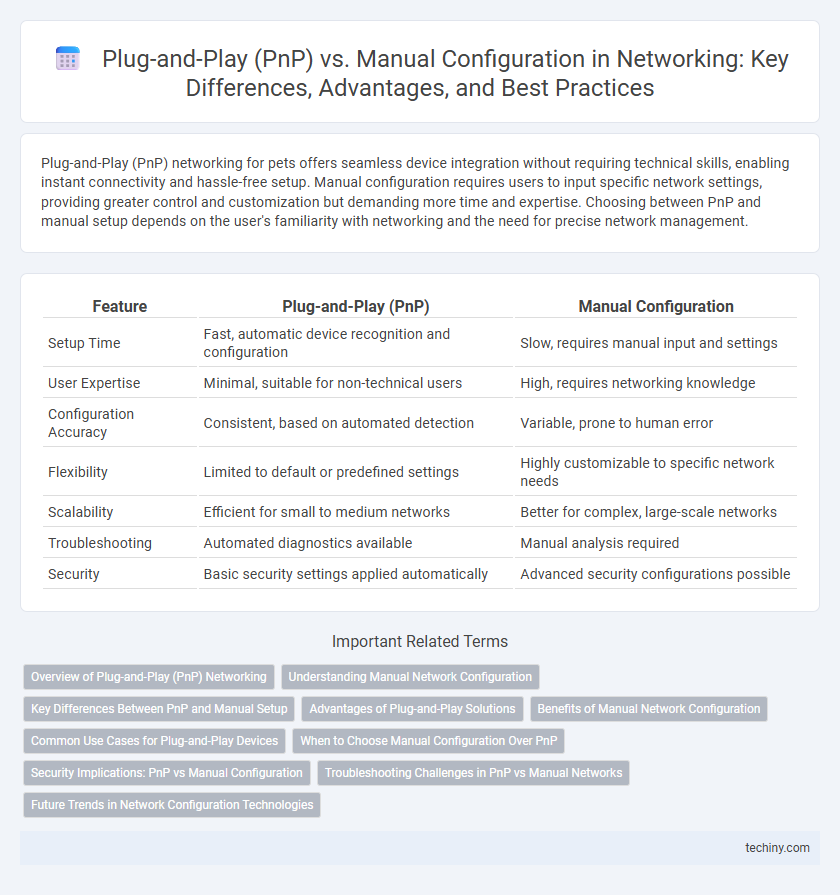Plug-and-Play (PnP) networking for pets offers seamless device integration without requiring technical skills, enabling instant connectivity and hassle-free setup. Manual configuration requires users to input specific network settings, providing greater control and customization but demanding more time and expertise. Choosing between PnP and manual setup depends on the user's familiarity with networking and the need for precise network management.
Table of Comparison
| Feature | Plug-and-Play (PnP) | Manual Configuration |
|---|---|---|
| Setup Time | Fast, automatic device recognition and configuration | Slow, requires manual input and settings |
| User Expertise | Minimal, suitable for non-technical users | High, requires networking knowledge |
| Configuration Accuracy | Consistent, based on automated detection | Variable, prone to human error |
| Flexibility | Limited to default or predefined settings | Highly customizable to specific network needs |
| Scalability | Efficient for small to medium networks | Better for complex, large-scale networks |
| Troubleshooting | Automated diagnostics available | Manual analysis required |
| Security | Basic security settings applied automatically | Advanced security configurations possible |
Overview of Plug-and-Play (PnP) Networking
Plug-and-Play (PnP) networking automates device recognition and configuration, enabling seamless integration without user intervention. It utilizes protocols like DHCP and UPnP to dynamically assign IP addresses and configure network settings, reducing setup time and minimizing errors. PnP enhances network scalability and user experience by supporting automatic device discovery and configuration in diverse networking environments.
Understanding Manual Network Configuration
Manual network configuration involves explicitly setting IP addresses, subnet masks, gateways, and DNS servers on network devices, offering precise control over network parameters. This method is essential in environments requiring customized network settings, enhanced security, or integration with legacy systems that lack plug-and-play support. Understanding manual configuration enables network administrators to troubleshoot connectivity issues effectively and optimize network performance in complex infrastructures.
Key Differences Between PnP and Manual Setup
Plug-and-Play (PnP) networking automates device recognition and configuration using protocols like DHCP and UPnP, greatly reducing setup time and minimizing human error. Manual configuration requires administrators to assign IP addresses, subnet masks, and other settings individually, providing greater control but increasing complexity and potential for misconfiguration. PnP is ideal for dynamic environments needing quick scalability, while manual setup suits stable networks demanding precise customization.
Advantages of Plug-and-Play Solutions
Plug-and-Play (PnP) networking solutions drastically reduce setup time by automatically detecting and configuring devices without user intervention, enhancing productivity and minimizing errors. These solutions increase network scalability through seamless integration of new hardware, supporting dynamic environments with minimal downtime. PnP technology also simplifies device management and troubleshooting, promoting consistent configurations across complex network infrastructures.
Benefits of Manual Network Configuration
Manual network configuration offers precise control over IP addressing, subnetting, and routing, enhancing network security and performance by allowing customized settings tailored to specific organizational needs. It enables network administrators to troubleshoot issues more effectively and apply advanced configurations that Plug-and-Play systems may not support. This level of control minimizes potential conflicts and optimizes bandwidth usage for critical applications.
Common Use Cases for Plug-and-Play Devices
Plug-and-Play (PnP) devices are commonly used in home networks and small office environments where ease of setup and minimal technical knowledge are essential. They are ideal for connecting peripherals such as printers, cameras, and IoT devices, allowing automatic configuration and quick integration without user intervention. PnP technology enhances network scalability by enabling seamless addition of new devices while reducing configuration errors and setup time compared to manual configuration.
When to Choose Manual Configuration Over PnP
Manual configuration is preferable in complex networking environments requiring precise control over IP addressing, routing protocols, and security policies that Plug-and-Play (PnP) cannot adequately customize. Enterprise networks with legacy devices or stringent compliance standards often demand manual setup to ensure stability and adherence to organizational policies. When troubleshooting connectivity issues or deploying specialized services, manual configuration provides granular control that enhances network performance and reliability.
Security Implications: PnP vs Manual Configuration
Plug-and-Play (PnP) networking simplifies device setup by automatically configuring network settings, but it can introduce security vulnerabilities if unauthorized devices gain access during the auto-discovery phase. Manual configuration requires explicit credential entry and device authorization, reducing risks of unauthorized access and network breaches. Enterprises prioritize manual configuration for sensitive environments to enforce strict access controls and minimize exposure to cyber threats.
Troubleshooting Challenges in PnP vs Manual Networks
Plug-and-Play (PnP) networking simplifies device integration by automatically detecting and configuring devices, but it often obscures underlying network issues, making troubleshooting more complex due to limited visibility into configuration details. Manual configuration provides granular control over network settings, enabling precise identification and resolution of connectivity problems, yet it requires detailed knowledge and can be time-consuming to diagnose errors caused by human misconfiguration. The trade-off between PnP's ease of use and manual setup's diagnostic transparency significantly impacts network troubleshooting efficiency and accuracy.
Future Trends in Network Configuration Technologies
Future trends in network configuration technologies emphasize automation and intelligence, with Plug-and-Play (PnP) solutions leveraging AI and machine learning to enable self-configuring, self-optimizing networks that minimize human intervention. Manual configuration, while still relevant for complex or legacy systems, is gradually being supplemented or replaced by dynamic, policy-driven frameworks that enhance scalability and security. Advances in software-defined networking (SDN) and intent-based networking (IBN) promise seamless integration of PnP capabilities, accelerating deployment and reducing configuration errors across large-scale enterprise and cloud environments.
Plug-and-Play (PnP) vs Manual Configuration Infographic

 techiny.com
techiny.com